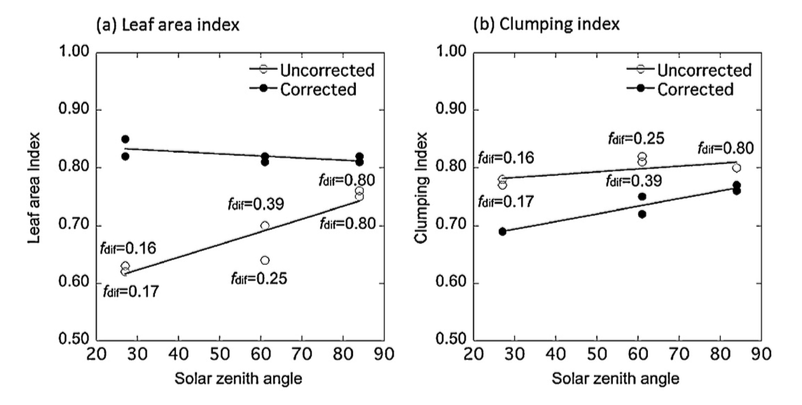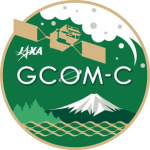Contents
3次元植生放射伝達モデル(FLiES)の開発
モデルの概要
2004年から継続して植生キャノピーの放射伝達モデル開発と改良を進めています。Forest Light Environmental Simulator (FLiES)は1次元の大気と3次元森林景観との間の放射過程をシミュレーションすることが出来ます。現在ホームページで公開している安定版では水平な森林景観の短波長(単波長、合成有効放射400-700nm, 全短波350nm-4000nm)の光環境計算を行うことができます。定期的に国際放射モデル比較実験(RAMI)に参加し、FLiESの不確実性を評価しています。モデルの詳細については放射伝達コードのメニューをごらんください。なお、安定版には付加されていませんがFLiESには以下の様な計算モジュールがあり順次公開を予定しています。
- 長波(熱赤外)の放射計算
- Waveform LiDARシグナルのシミュレーション
- 太陽光励起クロロフィル蛍光(SIF)の計算
- 傾斜地における森林の放射計算
- 地上・航空機LiDARから抽出されるボクセルデータの利用
応用例1:Plant Canopy Analyzerの散乱補正アルゴリズムの開発
Plant Canopy Analyzer, LAI-2200C(LAI-2200C, LiCOR Inc)は森林や農地における林床の450nm近傍の光の透過率からギャップ確率を推定する測器です。さらにギャップ確率から葉面積指数(LAI)などの生態系パラメータを推定することもできます。LAI-2200の前バージョンであるLAI-2000では、葉をブラック(反射も透過もしない)と仮定していましたが実際には数%の反射光と透過光があり、その誤差が無視できない場合があります。そこで新たに散乱補正アルゴリズムを開発し、その精度をFLiESを用いて検証しました。新たな散乱補正アルゴリズムはLiCORの提供するソフトfv2200に実装されており、以下のサイト(https://www.licor.com/env/products/leaf_area/LAI-2200/software.html)からダウンロード可能です。アルゴリズムの詳細は、以下の論文にまとめられています。
(関連論文)Kobayashi, H., Y. Ryu, D. D. Baldocchi, J. M. Welles, J. N. Norman (2013). On the correct estimation of gap fraction: How to remove scattered radiation in gap fraction measurements? Agricultural and Forest Meteorology, 174-175, 170-183.
応用例2:様々な大気・森林景観における群落光合成
様々な大気条件(エアロゾルの光学的厚さ)での入射光条件し、異なるLAI及び樹冠形状を持る森林景観で光合成速度を計算しました。その結果、群落レベルの光合成速度は、LAIだけでなく樹冠形状にも関係することがわかりました。
(関連論文)Kobayashi, H. and H. Iwabuchi (2008), A coupled 1-D atmosphere and 3-D canopy radiative transfer model for canopy reflectance, light environment, and photosynthesis simulation in a heterogeneous landscape, Remote Sensing of Environment, 112, 173-185.
応用例3:光合成有効放射・短波放射のグローバル推定
Microsoftとカリフォルニア大学バークレー校の共同研究として実施されたMicrosoft Azure(クラウドサーバー)上でのMODISデータを用いた全球光合成量、蒸発散量推定モデル開発(BESS, Breathing Earth System Simulator)において、光合成有効放射と短波日射の推定にFLiESが利用されています。
(関連論文)Ryu, Y., D. Baldocchi, H. Kobayashi, C. Ingen, J. Li, A. Black, J. Beringer, E. Gorsel, A. Knohl, B. Law, A. Richardson, O. Roupsard (2011), Integration of MODIS land and atmosphere products with a coupled-process model to estimate gross primary productivity and evapotranspiration from 1 km to global scales, Global Biogeochemical Cycles, 25, GB4017, doi:10.1029/2011GB004053.
応用例4:JAXAの気候変動観測衛星による葉面積指数推定
2016年度に打ち上げが予定されているJAXAの気候変動観測ミッションGCOM-Cの陸域プロダクト(葉面積指数および光合成有効放射吸収率)の逆推定アルゴリズム構築にFLiESが利用されています。現在、衛星の打ち上げに向けてアルゴリズムの開発が進められています。
FLiESを利用した論文一覧
- 押尾晴樹、浅輪貴史、梅干野晁、宮坂 聡 (2015),マルチリターン航空機LiDARデータと植生放射伝達モデルによる都市緑化樹木の日射遮蔽効果の計量化, 日本リモートセンシング学会誌、l. 35 No. 1, pp. 10-23.
- Widlowski, J-L, C. Mio, M. Disney, J. Adams, I. Andredakis, C. Atzberger, J. Brennan, L Busetto, M. Chelle, G Ceccherini, R Colombo, J-F Côté, A. Eenmäe, R. Essery, J-P. Gastellu-Etchegorry, N. Gobron, E.Grau, V. Haverd, L. Homolová, H. Huang, L. Hunt, Kobayashi , B. Koetz, A. Kuusk, J. Kuusk, M. Lang, P. E. Lewis, J. L. Lovell,Z. Malenovsky, M. Meroni, F. Morsdorf, M. Mõttus, T. Nilson, W. Ni‐Meister, B. Pinty, M. Rautiainen, M. Schlerf, B. Somers, J. Stuckens, M. M. Verstraete, W. Yang, F. Zhao, T. Zenone, (2015), The fourth phase of the radiative transfer model intercomparison (RAMI) exercise: Actual canopy scenarios and conformity testing, Remote Sensing of Environment, 169, 418–437
- Osuna, J., D. Baldocchi, Kobayashi , T. E. Dawson, (2015), Seasonal Trends in Photosynthesis and Electron Transport During the Mediterranean Summer Drought in Leaves of Deciduous Oaks, Tree Physiology 00, 1–16 doi:10.1093.
- Maki M. and K. Homma (2014), Empirical Regression Models for Estimating Multiyear Leaf Area Index of Rice from Several Vegetation Indices at the Field Scale, Remote Sensing 2014, 6(6), 4764-4779; doi:10.3390/rs6064764.
- Yang, W., Kobayashi, R. Suzuki, K. N. Nasahara (2014), A Simple Method for Retrieving Understory NDVI in Sparse Needleleaf Forests in Alaska Using MODIS BRDF Data, Remote Sensing, 6, no. 12: 11936-11955.
- Kobayashi H., R. Suzuki, S. Nagai, T. Nakai, Y. Kim (2014), Spatial scale and landscape heterogeneity effects on FAPAR in an open canopy black spruce forest in interior Alaska, IEEE Geoscience and Remote Sensing Letters, Volume 11 , Issue 2, 564-568, 10.1109/LGRS.2013.2278426.
- Widlowski, J-L.., B. Pinty, M. Lopatka, C. Atzberger, D. Buzica, M. Chelle, M. Disney, J-P. Gastellu-Etchegorry, M. Gerboles, N. Gobron, E. Grau, H. Huang, A. Kallel, Kobayashi, P. E. Lewis, W. Qin, M. Schlerf, J. Stuckens, D. Xie (2013), The 4th Radiation Transfer Model Intercomparison (RAMI-IV): Proficiency Testing of Canopy Reflectance Models with ISO-13528, Journal of Geophysical Research, VOL. 118, 1–22, doi:10.1002/jgrd.50497.
- Kobayashi, H., Ryu, D. D. Baldocchi, J. M. Welles, J. N. Norman (2013). On the correct estimation of gap fraction: How to remove scattered radiation in gap fraction measurements? Agricultural and Forest Meteorology, 174-175, 170-183.
- Kobayashi, H., D. Baldocchi, Y. Ryu, Q. Chen, S. Ma, J. Osuna, S. Ustin (2012), Modeling Energy and Carbon Fluxes in a Heterogeneous Oak Woodland: A Three-Dimensional Approach, Agricultural and Forest Meteorology, Agricultural and Forest Meteorology, 152, 83-100.
- Ryu, Y., D. Baldocchi, Kobayashi, C. Ingen, J. Li, A. Black, J. Beringer, E. Gorsel, A. Knohl, B. Law, A. Richardson, O. Roupsard (2011), Integration of MODIS land and atmosphere products with a coupled-process model to estimate gross primary productivity and evapotranspiration from 1 km to global scales, Global Biogeochemical Cycles, 25, GB4017, doi:10.1029/2011GB004053.
- Suzuki, R., H Kobayashi, Delbart, J. Asanuma, T. Hiyama (2011), NDVI responses to the forest canopy and floor from spring to summer observed by airborne spectrometer in eastern Siberia. Remote Sensing of Environment, 115, 3615-3624.
- Widlowski, J-L., B. Pinty, M. Clerici, Y. Dai, M. De Kauwe, K. de Ridder,A. Kallel, Kobayashi , T. Lavergne, W. Ni-Meister, A. Olchev, T. Quaife, S. Wang, W. Yang, Y. Yang, H. Yuan (2011), RAMI4PILPS: An Intercomparison of Formulations for the Partitioning of Solar Radiation in Land Surface Models, Journal of Geophysical Research, 116, G02019, doi:10.1029/2010JG001511.
- Kobayashi, H., N. Delbart, R. Suzuki, K. Kushida (2010), A satellite-based method for monitoring seasonality in the overstory leaf area index of Siberian larch forest, Journal of Geophysical Research, 115, G01002, doi:10.1029/2009JG000939.
- Ryu, Y., O. Sonnentag, T. Nilson, R. Vargas, Kobayashi, R. Wenk, D. D. Baldocchi (2010), How to quantify tree leaf area index in an open savanna ecosystem: A multi-instrument and multi-model approach, Agricultural and Forest Meteorology, 150: 63-76
- 橋本直之, 牧雅康, 田中賢治, 田村正行, 作物農事暦推定にむけたLAI時系列変化パターン抽出方法の検討, 日本リモートセンシング学会誌, 29, pp. 381-391, 2009.
- 小林秀樹 (2008), 針葉樹における分光反射率と葉面積指数の関係:森林の三次元構造とクランピングの影響, 日本リモートセンシング学会誌,28(4),350-356.
- Kobayashi, H. and H. Iwabuchi (2008), A coupled 1-D atmosphere and 3-D canopy radiative transfer model for canopy reflectance, light environment, and photosynthesis simulation in a heterogeneous landscape, Remote Sensing of Environment, 112, 173-185.
- Kobayashi, H, R. Suzuki, S. Kobayashi (2007), Reflectance seasonality and its relation to the canopy leaf area index in an eastern Siberian larch forest: Multi-satellite data and radiative transfer analyses, Remote Sensing of Environment, 106, 238-252.
-
衛星データによる生態系物理量及び土地被覆推定(順次整備します)
葉面積指数の推定
アラスカにおけるフェノロジー推定とその検証
-
生態系モデル及び微気象モデルによる炭素・水収支解析(順次整備します)
-
CASAモデルによる東南アジアの純一次生産量推定
-
熱・水・炭素収支シミュレーション
カリフォルニアのオーク疎林にCANOAKとFLiESを適用し水・熱・炭素収支の数値シミュレーションを行いました。
-




